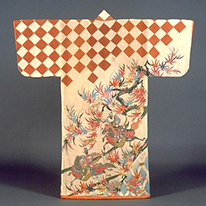Past Exhibitions
- Yūzen Dyeing
- January 31, 2017 - March 12, 2017
Today we take it for granted that kimono have a wide range of patterns, designed as freely as paintings, but this was only made possible by the advent of yūzen dyeing during the Edo period (1615–1868). Until the 1600s, tie-dyeing, embroidery, and pasted gold or silver foil were the main methods for producing decorative patterns on kimono. Then the paste-resist and hand-painting techniques of yūzen dyeing were developed. This revolutionary process no longer necessitated dipping the fabric into dye vats but instead allowed colors to be applied directly to the fabric surface, as if painting in a coloring book. Yūzen dyeing allowed textile producers to create pictorial patterns using a broad palette of colors. The technique came into vogue around the Genroku era (1688–1703), which is remembered as a particularly glamorous time, and it is still used to create kimono patterns today. This exhibit showcases the allure of yūzen dyeing and outlines the course of its history.












